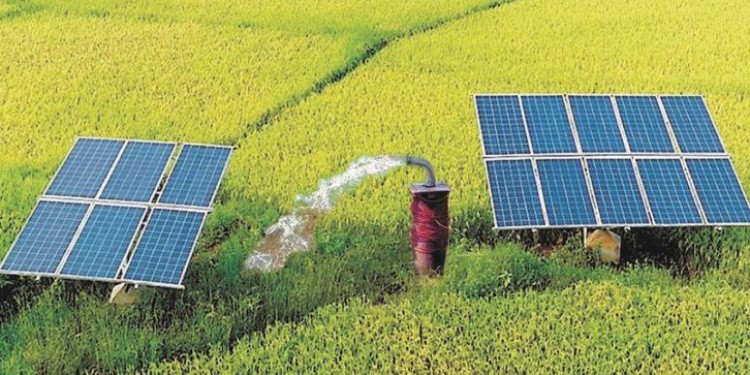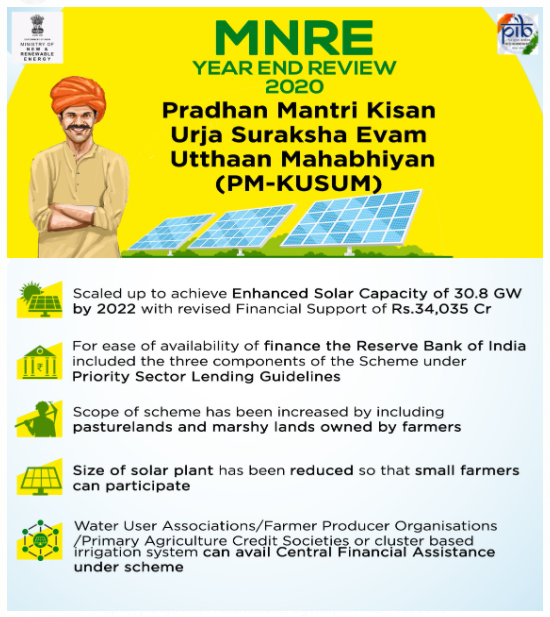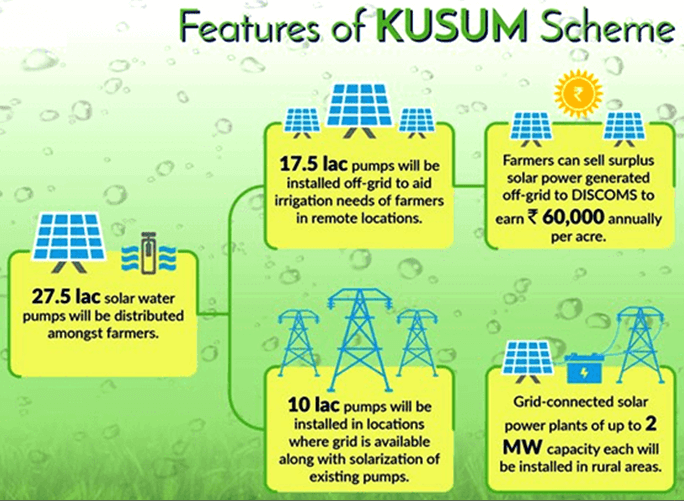Description

Copyright infringement not intended
In News
- The Union Minister of State for New and Renewable Energy (MNRE) has stated in the Lok Sabha that the government has started the PM-KUSUM with the objectives of;
- De-dieselisation of the farm sector.
- Providing water and energy security to farmers.
- Increasing the income of farmers and curbing environmental pollution.
About PM Kusum
- The Ministry of New and Renewable Energy (MNRE) has launched the Pradhan Mantri Kisan Urja Suraksha evem Utthan Mahabhiyan (PM KUSUM) Scheme for the installation of solar pumps and grid-connected solar and other renewable power plants in the country.
- The scheme aims to add solar and other renewable capacities of 25,750 MW by 2022 with a total central financial support of Rs. 34,422 Crore including service charges to the implementing agencies.
The Scheme consists of three components
- Component A: 10,000 MW of Decentralized Ground Mounted Grid Connected Renewable Power Plants of individual plant size up to 2 MW.
- Component B: Installation of 17.50 lakh standalone Solar Powered Agriculture Pumps of individual pump capacity up to 7.5 HP.
- Component C: Solarisation of 10 Lakh Grid-connected Agriculture Pumps of individual pump capacity up to 7.5 HP.


Copyright infringement not intended
Significance of the Scheme
- Increase in income: This program provides landowners with a stable and continuous source of income for 25 years by using dry /non-cultivable land.
- Employment: It will also help increase green energy production and create jobs in rural areas, later enabling the government sector to solarize pipe wells and pump water irrigation projects.
- Energy availability and security: This system makes available local solar/other renewable energy sufficient to power rural load centres and agricultural pump units that primarily need electricity during the day.
- Reduction of transmission loss: These power plants are distributed near agricultural loads or substations, reducing transmission losses for STUs and Discom. In addition, this program helps Discom achieve its RPO goals.
- Cost reduction: Solar pumps save diesel costs for operating diesel pumps and provide farmers with a reliable source of irrigation through solar pumps.
- Environmentally Friendly: This program helps prevent harmful pollution from the operation of diesel pumps.
- Achieve national goals: This supports India's commitment to increase the percentage of installed electricity capacity from non-fossil fuels to 40% by 2030.
Challenges
- Regulation: Very few federal states have started bidding or commissioning projects for solar feed-ins or grid-connected pumps.
- Operational and technical: Discoms are more utility than distributed PV (under the program) because of the higher cost of distributed PV and the loss of location benefits due to the exemption from interstate transmission system (ISTS) fees.
- Financially: The current barriers to their introduction are concerns about their economic feasibility in the face of high agricultural subsidies, supplying excess electricity when selling water or irrigating additional land.
- Lack of Credit: In addition, many unsecured farmers do not have access to bank credit.
- Lack of trust: The grid connection model requires the pump to be measured and billed for billing, but lacks trust between the farmer and the nightclub.
- Awareness: barriers include limited awareness of solar pumps and the inability of farmers to pay upfront payments.
- COVID: The pandemic turmoil, limited purchases from the state, and implementation challenges all affected the implementation of the program.
Way Forward
- Extending the Scheme: Extending PM KUSUM's schedule to 2022 and beyond will allow DISCOM to coordinate this scheme with its electricity procurement plan.
- Create a fair competition for distributed solar systems: To counter the prejudice against distributed solar energy, address substation counterparty risk and grid failure risk, and standardize pricing to reflect the higher costs of distributed power plants and solar system ISTS.
- Optimize land management: Optimize land management through coordination between departments. This helps reduce delays in leasing or converting farmland for non-agricultural purposes such as solar power.
- Innovative solution: The government should innovative solutions to fund the contributions of farmers. Government need out-of-the-box solutions, such as the Karnataka pilot project, a special vehicle for farmers to help farmers install solar power plants on their farms.
- Intelligent solution: Build trust by deploying solutions such as smart meters and smart transformers and working with farmers.
https://www.pib.gov.in/PressReleasePage.aspx?PRID=1843536
1.png)
https://t.me/+hJqMV1O0se03Njk9










